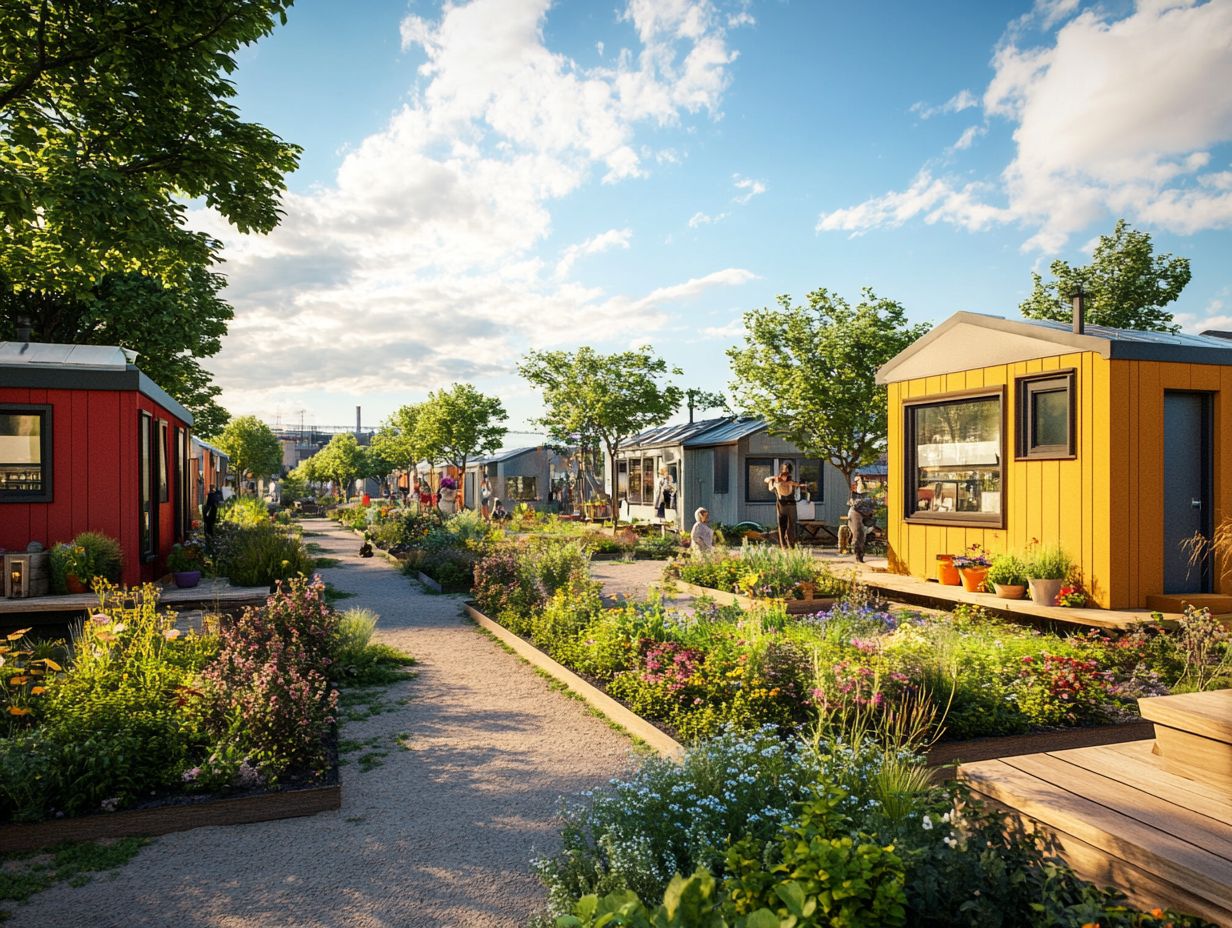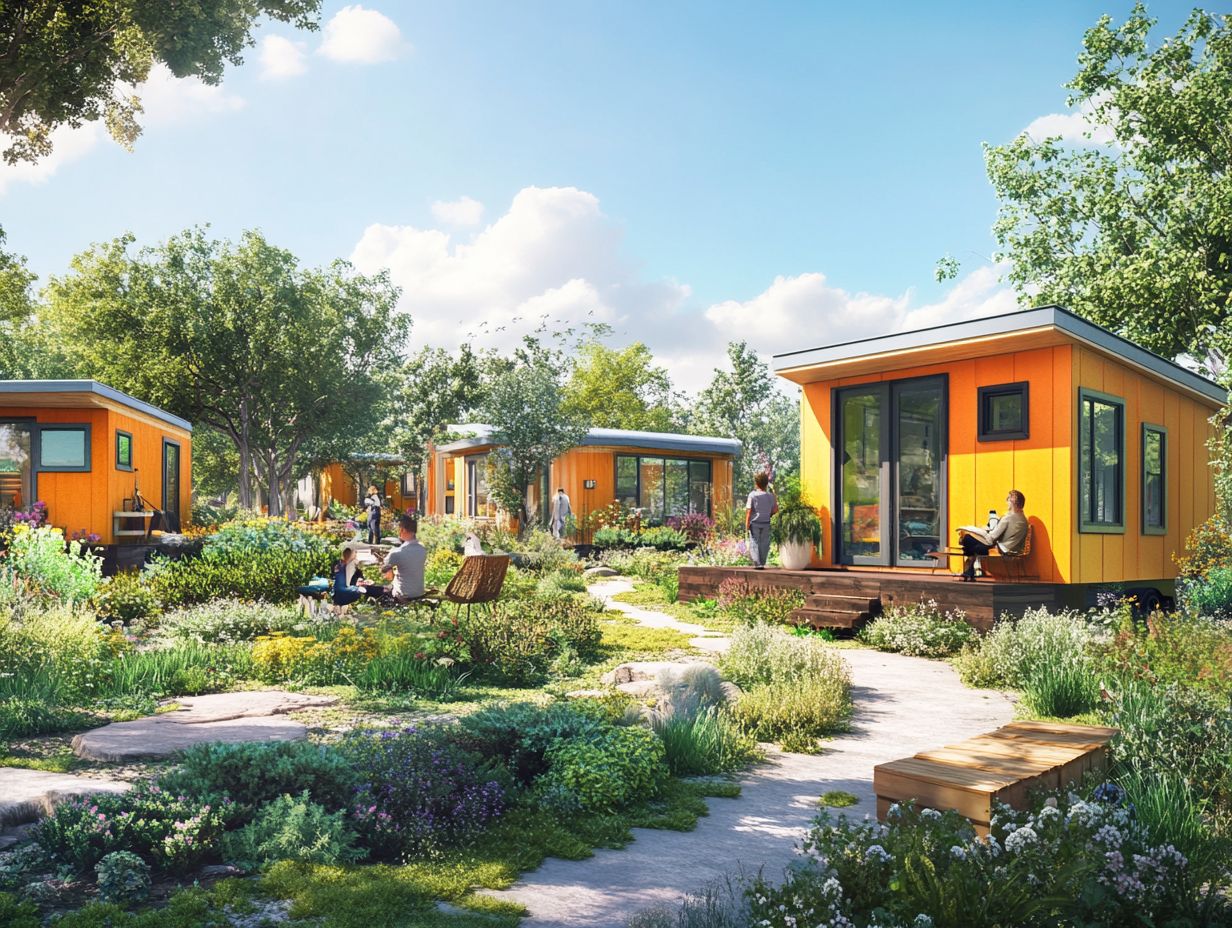Tiny House Communities and Mental Health Benefits
Tiny house communities are more than a fleeting trend; they embody a lifestyle choice that embraces simplicity, sustainability, and meaningful connection.
This exploration delves into these distinctive living spaces and their purpose. You ll discover the mental health benefits of communal living, including reduced stress and an enhanced sense of belonging.
However, there are challenges to consider as well. If you re intrigued by the idea of finding and joining a tiny house community that aligns with your values, we provide valuable resources and tips to guide you.
Join us as we explore the exciting world of tiny house living!
Contents
- Key Takeaways:
- What are Tiny House Communities?
- Mental Health Benefits of Living in a Tiny House Community
- Challenges and Considerations
- How to Find and Join a Tiny House Community
- Frequently Asked Questions
- What are tiny house communities and how do they promote mental health benefits?
- How do tiny house communities support a sense of community connection and belonging?
- Can living in a tiny house community help reduce feelings of isolation and loneliness while promoting mental health?
- Are there mental health benefits to downsizing and simplifying one’s living space, particularly in relation to a minimalist lifestyle?
- What role does nature play in promoting mental health in tiny house communities, especially in terms of outdoor time?
- How do tiny house communities promote sustainable living and mental well-being through eco-friendly practices?
Key Takeaways:

- Living in a tiny house community can lead to improved mental health by reducing stress and anxiety.
- Community living fosters a sense of belonging and support, nurturing emotional well-being.
- Before joining a tiny house community, consider potential challenges and actively work on maintaining healthy community dynamics.
What are Tiny House Communities?
Tiny house communities represent a growing trend focused on cultivating an intentional lifestyle rooted in compact living, environmental sustainability, and meaningful community connections. These communities attract individuals who embrace simple living by choosing to reside in tiny houses, aligning with the tiny house movement.
These homes are not only more affordable, but they also champion ecological responsibility through resource efficiency and reduced clutter. Given the escalating housing crisis, many are gravitating toward these innovative solutions that blend secure shelter with an environment that nurtures well-being, proving to be cost-effective living options.
Definition and Purpose
The concept of Tiny House Communities centers on shared spaces, resource efficiency, and a dedication to eco-friendly living.
These communities promote financial freedom by lowering living costs through compact housing footprints and collaborative resource sharing. Residents often prioritize environmental sustainability, choosing eco-friendly materials and practices to minimize their ecological impact.
Living in close quarters allows members to cultivate meaningful social connections that enhance their quality of life, creating networks that often resemble extended families. This lifestyle fosters a profound sense of belonging while encouraging a minimalist approach that harmonizes personal well-being with a commitment to the planet.
In essence, tiny house living is a personal and collective journey toward a more fulfilling existence.
Mental Health Benefits of Living in a Tiny House Community
Residing in a Tiny House Community offers numerous mental health advantages, thanks to its focus on fostering social connections, minimizing clutter, and embracing a minimalist lifestyle that significantly enhances emotional well-being.
Reduced Stress and Anxiety

The tiny house movement is a compelling solution for reducing stress and anxiety due to its emphasis on simplicity and minimal possessions. This lifestyle promotes emotional well-being by reducing clutter and embracing environmental sustainability.
By encouraging you to downsize your living space and belongings, this lifestyle fosters a sense of clarity. Imagine reclaiming the time and mental energy once devoted to maintaining larger homes or navigating cluttered environments. In doing so, you can focus on what truly matters, significantly enhancing your mental health.
With fewer distractions and obligations, you may find it easier to engage in mindfulness practices, nurturing your emotional state even further. Each intentional choice made in a compact living environment reinforces your commitment to personal values and cultivates a more tranquil existence.
Stronger Sense of Community
Tiny House Communities foster a strong sense of belonging. Social connections and supportive friendships thrive through shared experiences and resources.
Residents engage in communal activities like gardening, workshops, and social gatherings. These activities strengthen relationships and boost emotional well-being.
By focusing on shared responsibilities, these communities tackle loneliness and isolation, which are common in today s fast-paced world.
This collaborative living model boosts individual happiness and builds a vibrant social network. This network is essential for mental strength, contributing to overall well-being.
Challenges and Considerations
While the benefits of living in a Tiny House Community are appealing, challenges exist. You may need to navigate new organizational decisions.
Adapting to smaller living spaces and community dynamics requires thoughtful changes and an open mind.
Adjusting to Small Living Spaces
Embracing small living spaces invites you to make smart organizing choices. Prioritize space efficiency while adopting space-saving designs.
Adopting a minimalist mindset can elevate your experience. Prioritize essentials and seek multifunctional furniture that serves various purposes.
Consider innovative storage solutions like wall-mounted shelves and under-bed drawers. These ideas can help free up floor space while keeping belongings accessible.
Incorporating vertical gardens or using foldable furniture creates an open atmosphere. These practical adjustments help you adapt while reflecting your personal style.
Community Dynamics and Conflict Resolution

Understanding community dynamics in Tiny House Communities is essential. Strong social connections and camaraderie help resolve conflicts and nurture harmony.
In these close-knit settings, effective communication is key. Engage in open dialogue and actively listen to your neighbors concerns.
Addressing issues promptly helps resolve conflicts and strengthens bonds. Community meetings provide structured opportunities for everyone to share their thoughts.
By embracing constructive feedback and setting interaction ground rules, communities foster a sense of belonging. This promotes well-being and minimizes interpersonal friction.
How to Find and Join a Tiny House Community
Finding and joining a Tiny House Community involves using various resources. This journey connects you with like-minded individuals and enriches your path to financial freedom and sustainable living.
Resources and Tips for Finding the Right Community
As you seek the perfect Tiny House Community, many resources and tips are available. Discover the charm of the tiny house movement and explore new ideas and tools that enhance communal living, including options for short-term rentals.
Explore online platforms like Tiny House Listings. Engage with social media networks focused on sustainable living to connect with others who share your passions.
Community gardens are vital in these spaces. They foster social interaction and self-sufficiency, providing access to fresh produce.
Look at successful examples like the EcoVillage in Ithaca, New York. These vibrant communities encourage collaboration and caring for the environment.
By tapping into these networks, you can find a community that aligns with your modern, eco-friendly lifestyle.
Frequently Asked Questions
What are tiny house communities and how do they promote mental health benefits?

Tiny house communities are neighborhoods made up of small homes designed for sustainable living. They offer a simpler lifestyle that can reduce stress and anxiety, enhancing mental health.
How do tiny house communities support a sense of community connection and belonging?
A core principle of tiny house communities is fostering a strong sense of community. Residents share spaces and participate in activities, creating support among neighbors.
Can living in a tiny house community help reduce feelings of isolation and loneliness while promoting mental health?
Yes, these communities offer a close-knit environment. Neighbors form meaningful connections and provide emotional support to one another.
Are there mental health benefits to downsizing and simplifying one’s living space, particularly in relation to a minimalist lifestyle?
Absolutely! Downsizing can reduce stress and anxiety. It encourages mindful living, improving overall mental well-being.
What role does nature play in promoting mental health in tiny house communities, especially in terms of outdoor time?
Many tiny house communities are set in beautiful natural surroundings. Being in nature has a calming effect, making these communities even more beneficial.
How do tiny house communities promote sustainable living and mental well-being through eco-friendly practices?
These communities focus on sustainable practices like renewable energy and waste reduction. This not only helps the environment but also brings a sense of purpose that boosts mental health.






